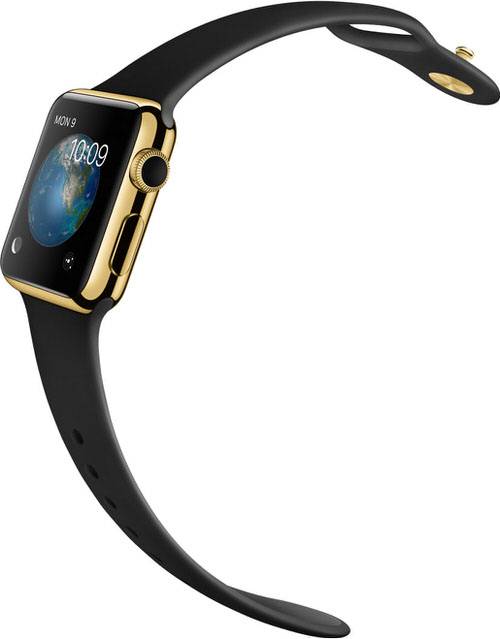With Monday’s big Apple event over and done with, we now have more information about the Apple Watch than ever before—or, at least, a few more bits than we previously knew.
Call it a teaser: The public will have its chance to check out the watch up close in stores starting April 10, when pre-orders open. But in the meantime, the broad strokes that Apple painted about its first wearable device seem ripe for a few comparisons with the competition.
See also: What Did We Just Learn About The Apple Watch? Not Much
Ultimately, the main question is whether the Apple Watch does anything that other smartwatches don’t. The short answer is yes—but not much.
Cooler Than A Shoe Phone, I Guess
The public was already acquainted with most of the Apple Watch features the company reiterated Monday. Features such as Siri, fitness tracking and messaging held no surprises.
The Apple Watch does offer an interesting feature, however: the ability to take calls right from your wrist. This feature puts it in competition with the likes of the Tizen-running Samsung Gear S, as well as an upcoming new smartwatch from LG, which will run a brand new OS, among others.

Unlike those rivals, however, the Apple Watch—which connects to iPhones over Bluetooth—will be able to make or take calls without requiring its own SIM card. That’s a trick that no commercially available Android Wear watch can pull off yet.
There’s good news and bad with that: Wrist-based calling is undoubtedly a unique option for Apple fans, and some users might find it handy. But it’s unclear if even Apple can make wrist-calls socially acceptable. There’s a high risk factor for looking like a jerk who may or may not be from the future—similar to the way Bluetooth headsets can make people look instantly uncool.
If appearances don’t matter, then consider the noise. Public transit already becomes irritating at times with run-of-the-mill mobile phone calls. That could escalate quickly if loads of people start chatting up their watches.
All Day Battery (If A Day Is 18 Hours)
Previously, Tim Cook stated that the watch will require daily charging. While he didn’t offer up details on battery capacity, he did say that it would last all day. Then he followed up that claim up with a figure of up to 18 hours.
Actual battery life depends on usage, which means people will experience some deviation. But even if the longevity was perfectly accurate, it’s still mediocre compared to the competition. Most smartwatches tend to settle in between 1 and 1.5 days of battery life (that is, aside from Pebble and its upcoming Pebble Time, whose e-paper screen allows for 5 to 7 days between charges).
See also: The Apple Watch Makes Its Play For The One Percent
However, the watch’s Power Reserve time—in which smart features are disabled, and the face only displays the time—kicks in when battery is low. This, according to Apple, can last up to three days. Android Wear devices like the Moto 360 also offer a low-power mode, though in ReadWrite’s real-world experience, it can’t hold a candle to Apple’s claims.
The company published a webpage detailing more specifics about the watch’s battery life. The power cell’s actual milliampere hour capacity remains missing, but the company disclosed results from its own testing using the 38 mm Watch model:
- All-Day Battery Life: Up to 18 hours
- Audio Playback Test: Up to 6.5 hours
- Watch Test (checking time): Up to 48 hours
- Charge Time: About 1.5 hours to 80%; about 2.5 hours to 100%
- Talk Time Test: Up to 3 hours
- Workout Test (exercising): Up to 7 hours
- Power Reserve (standby, displaying time only): Up to 72 hours
According to the webpage, the “42mm Apple Watch typically experiences longer battery life.”
The Price Is Fright
We knew back in September that the least expensive model—the 38 mm Apple Watch Sport with aluminum alloy—would start at $349. For another $50, the Sport’s body grows to 42 mm. Already, those prices exceed even the most expensive currently available Android smartwatch, LG’s $299 G Watch R (at least until the South Korean company releases its LG Watch Urbane).
From there, Apple Watch prices will cost you an arm and a leg, and maybe a few internal organs, depending on your tastes. The mid-tier, stainless steel Apple Watch starts at $549, with options that take its price up to $1,099. The Apple Watch Edition is made of 18-karat gold and starts at a whopping $10,000, with iterations that go all the way up to $17,000.

While we have yet to hear how much the recently announced Huawei Watch will cost, it seems unlikely that it will come close to even the mid-range Apple Watch’s pricing.
Apple has clearly raised the bar for how much a wearable device might cost. Put another way: Don’t be surprised if all smartwatches start to cost more.
The Best Brand Money Can Buy
The device also supports watch-to-watch communication. While not a new revelation, the feature does present something new and different that other smartwatches don’t currently offer. With this, users will be able to send real-time finger-doodles to watch-bearing contacts or their own virtual heart beats to loved ones, as well as virtual “taps” to capture friends’ attention.
Given Apple’s focus on fitness, the watch’s built-in heart-rate monitor should come as no surprise. Although the Motorola Moto 360, Samsung Gear Live and G Watch R beat Apple to the punch with heart-rate tracking, it’s certainly not standard yet. With this, Apple’s wearable can make somewhat more legitimate fitness-tracking claims than roughly half of today’s Android Wear devices.
Ultimately, there isn’t much that the Apple Watch can do that other devices can’t. But that’s not really the point. Apple didn’t set out to build just another smartwatch. (In fact, it eschews the label completely.) Instead, the company focused on offering a stylish status symbol made of premium materials. There’s no other reason to offer a $10,000 miniature iPhone slathered in gold.
Apple seems to believe that people won’t care about the technical and functional distinctions between the Apple Watch and the competition. What really matters, the company wagers, is whether your wearable of choice has the Apple logo stamped on the back.
Images courtesy of Apple

















